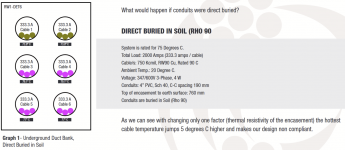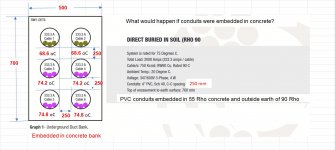I came across a couple of articles about cable ampacity/temperature for duct banks. One article was from a cable manufacturer, and the other article was from an engineering firm. Both articles said the design would be non-compliant once the conductor temperatures in the duct bank exceeded 75C, even though the conductors are 90C rated. Can someone explain why the cables can't be utilized up to their 90C rating for the underground portion of the circuit?
In the image below, they use 6 sets of 750 kcmil and the total load is 2,000 amps. The conductor ampacity at the 75C rated equipment terminations would be 475 amps * 6 sets = 2,850 amps. So no issue at the terminations.
NEC 110.14(C) says "Conductors with temperature ratings higher than specified for terminations shall be permitted to be used for ampacity adjustment, correction, or both." Wouldn't this apply due to mutual heating from underground ducts & ground being an insulator?

In the image below, they use 6 sets of 750 kcmil and the total load is 2,000 amps. The conductor ampacity at the 75C rated equipment terminations would be 475 amps * 6 sets = 2,850 amps. So no issue at the terminations.
NEC 110.14(C) says "Conductors with temperature ratings higher than specified for terminations shall be permitted to be used for ampacity adjustment, correction, or both." Wouldn't this apply due to mutual heating from underground ducts & ground being an insulator?


